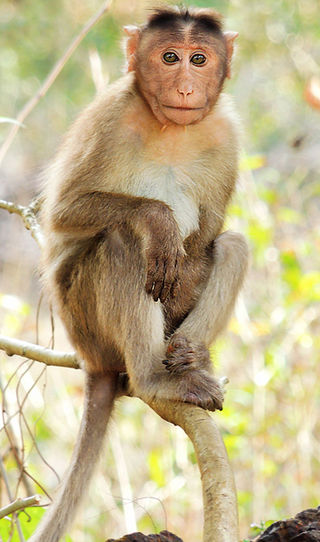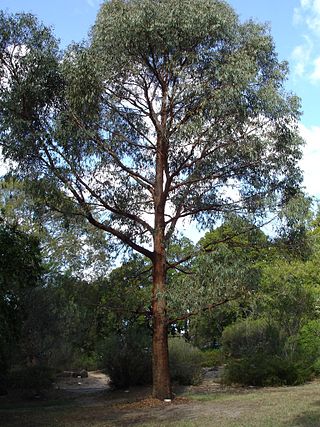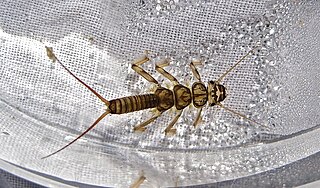
Pinus radiata, the Monterey pine, insignis pine or radiata pine, is a species of pine native to the Central Coast of California and Mexico. It is an evergreen conifer in the family Pinaceae.

Pinctada is a genus of saltwater oysters, marine bivalve mollusks in the family Pteriidae. These pearl oysters have a strong inner shell layer composed of nacre, also known as "mother of pearl".

The mung bean or green gram is a plant species in the legume family. The mung bean is mainly cultivated in East, Southeast and South Asia. It is used as an ingredient in both savoury and sweet dishes.

Radiata or Radiates is a historical taxonomic rank that was used to classify animals with radially symmetric body plans. The term Radiata is no longer accepted, as it united several different groupings of animals that do not form a monophyletic group under current views of animal phylogeny. The similarities once offered in justification of the taxon, such as radial symmetry, are now taken to be the result of either incorrect evaluations by early researchers or convergent evolution, rather than an indication of a common ancestor. Because of this, the term is used mostly in a historical context.

The bonnet macaque, also known as zati, is a species of macaque endemic to southern India. Its distribution is limited by the Indian Ocean on three sides and the Godavari and Tapti Rivers, along with its related competitor the rhesus macaque in the north. Land use changes in the last few decades have resulted in changes in its distribution boundaries with the rhesus macaque, raising concern for its status in the wild.

Gomortega keule is a species of tree endemic to Chile. It is the sole species of the genus Gomortega and, according to the APG IV system of 2016, of the monotypic family Gomortegaceae, assigned to the order Laurales in the clade magnoliids.

The radiated tortoise is a tortoise species in the family Testudinidae. Although this species is native to and most abundant in southern Madagascar, it can also be found in the rest of this island, and has been introduced to the islands of Réunion and Mauritius. It is a very long-lived species, with recorded lifespans of up to 188 years. These tortoises are classified as critically endangered by the IUCN, mainly because of the destruction of their habitat and because of poaching.

The clearfin lionfish, also called the tailbar lionfish, radiata lionfish, fireworks fish or radial firefish, is a carnivorous, ray-finned fish with venomous spines belonging to the family Scorpaenidae, the scorpionfishes and lionfishes. This species lives in the Indian and western Pacific Oceans. This is the only lionfish species which has spines without any markings. It can also be recognized by the pair of horizontal white stripes on its caudal peduncle.

Lycoris is a genus of 13–20 species of flowering plants in the family Amaryllidaceae, subfamily Amaryllidoideae. They are native to eastern and southern Asia in China, Japan, southern Korea, northern Vietnam, northern Laos, northern Thailand, northern Burma, Nepal, northern Pakistan, Afghanistan, and eastern Iran. They were imported into North Carolina and now grow wild. In English they are also called hurricane lilies or cluster amaryllis. The genus shares the English name spider lily with two other related genera.

Ecklonia radiata, commonly known as golden kelp, common kelp, spiny kelp or leather kelp, is a species of kelp found in the Canary Islands, the Cape Verde Islands, Madagascar, Mauritania, Senegal, South Africa, Oman, southern Australia, Lord Howe Island, and New Zealand. In Australia, E. radiata forms the backbone of the Great Southern Reef, a system of interconnected kelp reefs that spans the coastline of southern Australia, underpinning biodiverse and productive ecosystems, and supporting valuable ecosystem services.

Eucalyptus radiata, commonly known as the narrow-leaved peppermint or Forth River peppermint, is a species of tree that is endemic to south-eastern Australia. It has rough, fibrous to flaky bark on the trunk and larger branches, smooth grey bark on the thinner branches, lance-shaped to curved or almost linear leaves, flower buds in groups of eleven to twenty or more, white flowers and cup-shaped, hemispherical or shortened spherical fruit.

Paphiopedilum barbigerum is a species of flowering plant in the family Orchidaceae known commonly as the beard carrying paphiopedilum. It is native to China, Vietnam, and Thailand. It is an endangered species due to habitat destruction and overcollection for the horticultural trade.
Williamia is a genus of small sea snails or false limpets, marine pulmonate gastropod molluscs in the family Siphonariidae, the false (air-breathing) limpets.

Allograpta obliqua is a common North American species of hoverfly, commonly known as oblique streaktail. The larvae are important predators of aphids while adults are pollinators.

Lycoris radiata, known as the red spider lily, red magic lily, corpse flower, or equinox flower, is a plant in the amaryllis family, Amaryllidaceae, subfamily Amaryllidoideae. It is originally from China, Japan, Korea and Nepal and spread from there to the United States and elsewhere. It is considered naturalized in Seychelles and in the Ryukyu Islands. It flowers in the late summer or autumn, often in response to heavy rainfall. The common name hurricane lily refers to this characteristic, as do other common names, such as resurrection lily; these may be used for the genus as a whole.

Nomen illegitimum is a technical term used mainly in botany. It is usually abbreviated as nom. illeg. Although the International Code of Nomenclature for algae, fungi, and plants uses Latin terms as qualifiers for taxon names, the definition of each term is in English rather than Latin. The Latin abbreviations are widely used by botanists and mycologists.

The Syrphini are a tribe of hoverflies.

Allograpta exotica is a species in the family Syrphidae, in the order Diptera ("flies"). Larvae are often predators of aphids. Their life cycle from egg to adults is around 15 days, with adults living for approximately 10 days.

Claassenia is a genus of common stoneflies in the family Perlidae. There are about 12 described species in Claassenia.
















